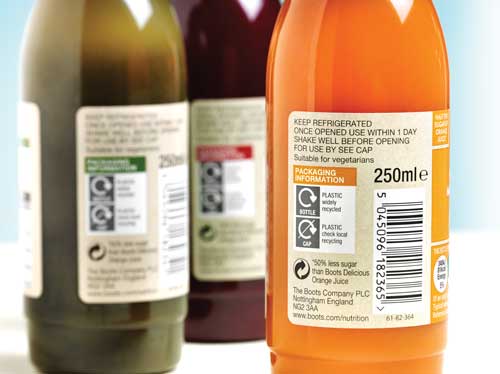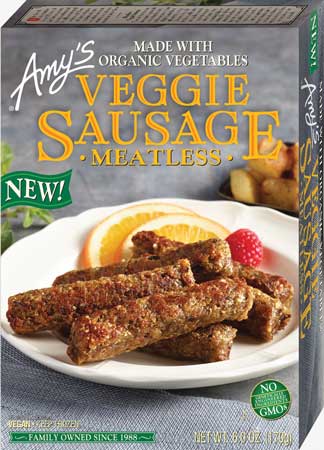Societal Factors Influence Packaging
PACKAGING
Three societal factors—social responsibility, health, and virtual decision making—are influencing food packaging decisions. Formal connections that link the value of post-consumer packaging to more sustainable package design exist, but in their absence, package design anthropocentrism (social influence and worldview) and guides that explain package sustainability to consumers are needed. The existence of more personalized and customized diets has resulted in an increase in package complexity. In addition, online purchasing of packaged foods has created a new array of opportunities.
 Social Responsibility
Social Responsibility
The increase in social responsibility for sustainable packaging is continuing to influence packaging design. Formal connections between the value of post-consumer packaging are affecting packaging decisions made by companies. Recycling rates can be used as a gauge for the value that society assigns to post-consumer packaging. For example, recycling aluminum cans results in a 95% energy savings in sourcing and manufacturing. Aluminum cans contain approximately 70% recycled content. Germany’s green-dot system results in the highest recycling rates in the European Union: 96% of aluminum cans are recycled in Germany. This type of formal connection between the economic value of post-consumer packaging and packaging selection by packaging professionals is made in every industrialized country except the United States. It guides packaging professionals in making decisions based on the financial value of the post-consumer package. When pay-as-you-throw systems—which charge for garbage collection and not recycling—are incorporated into municipalities, recycling rates increase. This could also sway consumers’ package selections; thus, economics can guide the decisions of both consumers and companies. “A meat tray produced in recyclable [polyethylene terephthalate] has higher economic value vs. a foam tray that incurs a cost for disposal,” says John More, president, Progressive Packaging.
Without a formal connection, the financial impact of post-consumer packaging is not linked to package selection at the company level. The monetary value of post-consumer packaging is simply not realized in the absence of a formal connection. Therefore, unless sustainable packages are equal or lower in cost, they are often not chosen. When a formal connection between package selection and post-consumer package value is absent, societal influences dominate.
To drive sustainability, a worldview needs to connect to tangible things that go unseen. For example, although the Great Pacific Garbage Patch is gaining in depth and breadth, few consumers and package designers will ever see it; similarly, few consumers and package designers see landfills or other examples of the immediate impact of not recycling. To increase recycling rates, packaging professionals, companies, and consumers need to be engaged to be part of the solution to an often unseen problem. This is the challenge in the absence of a formal system linking the value of post-consumer packaging to packaging decisions.
Decisions to select more sustainable packaging are partially defined by a conscious focus on anthropocentrism (i.e., the view that a single consumer’s actions will make a difference). This has taken many twists and turns. For example, expanded worldview campaign slogans such as “doing well by doing good,” “triple bottom line,” and “people, profit, planet” and the mandated 1990s light-weighting of U.S. packaging increased corporate understanding that costs can be reduced with more sustainable packaging. “Shared value” now tops the list of efforts and provides a pragmatic guide for companies grappling with ways to decrease food waste and packaging while remaining profitable. Companies that connect a larger worldview to more sustainable packaging have done well. For example, the PlantBottle by the Coca-Cola Co., Atlanta, Ga. (coca-colacompany.com), is made from non-oil-derived polyethylene terephthalate (PET) and is fully recyclable. By reducing the demand for oil, the PlantBottle pleases consumers and creates value for shareholders and bottling facilities. This kind of corporate responsibility eliminates the distinction between sustainability goals for corporations and those for consumers. The vast size of the Coca-Cola Co. means that many employees live in the same communities where there are product consumers. The company has expanded its worldview by offering a more sustainable package for the company, employees, and consumers.
Sustainable packaging solutions are complex: The multinational status of global food companies produces different results in different economies. For some societies, the value of packaging is connected with an informal economy where consumers often gather post-consumer packaging to sell. This is true in Detroit where returnable packaging is often a sole source of income. In regions where post-consumer packaging has a financial value, an expanded worldview would promote packaging with a high post-consumer value to increase recycling rates and income while being mindful of reducing food waste. If the value of recycled PET matched that of recycled aluminum, perhaps less PET would arrive in the Great Pacific Garbage Patch. With an expanded worldview, better package selection can alter choices. In fact, about 60% of consumers in Asia, Latin America, and the Middle East say they are willing to pay more for products and services provided by companies that are committed to positive social and environmental impacts.
The industry is taking direction from consumers and developing guides that identify which packaging components are recyclable and which are not. Labels such as the On-Pack Recycling Label (OPRL) in the United Kingdom make it easy for consumers to recycle more packaging. Use of this guide has expanded to 75,000 product lines and Aldi and Asda stores. Likewise, the OK Compost label is used for materials that are biodegradable and compostable in an industrial composting plant and applies to all components, inks, and additives.
 Health and Personalization
Health and Personalization
As society focuses on health and more personalized and customized diets, the complexity of packaging is increasing. Nutritional trends that include more unsaturated fats, no preservatives, and clean labeling are expanding the need for more complex package systems. For example, when omega-3 fats are added to foods, the products require packages with oxygen barriers, so the need for oxygen scavengers and other active packaging increases. Foods without preservatives require packages that reduce or prevent microbial growth. For example, in the bakery industry, preservative-free products can require modified active packaging, oxygen absorbers, and high barrier packaging to control microbial growth. These high-tech packages have replaced low-density polyethylene bread bags and would not be in use if preservative-free products were not in demand.
Other foods with sensitive ingredients require increased protection from oxidation, moisture loss or gain, and microbial growth. Gluten-free baked goods require specialized packaging and/or frozen storage. As the number of vegetarians around the world continues to grow, demands on packaging shift. More integrated processing and packaging solutions are needed that align with the sustainability concerns of these consumers. Some processed vegetarian products offer a shelf life of one year when frozen but only three to four days of shelf life in the refrigerator after opening. While removing energy-intensive frozen distribution and retail from these products would align with sustainability concerns of these consumers, more complex packaging would be needed to maintain food safety and increase shelf life. In addition, expanding urbanization increases the demand for complex packaging that extends shelf life and reduces waste from farm to consumer. This is especially true for products that are more perishable, such as fresh fruit and vegetables.
Health and personalization are also fueling innovation in the packaging of sports drinks. The smart cap on Gatorade products optimizes fluid recovery and includes a near field communication reader that guides optimal consumption of customized nutrient beverages. As health and personalization continue to be global issues, packaging that can meet the needs of more healthful foods and beverages is needed.
Virtual Decision Making
The online purchasing of packaged food is projected to increase by more than 100% over the next three years. This rise in virtual decision making has shifted the role of food packaging from in-store marketing to being a rapid and low-cost means of product shipping and meaningfully connecting with consumers. This shift in package design offers much opportunity for cost savings, sustainability, and in some cases, entirely new products. Packaging needed for e-commerce contrasts sharply with retail packaging. For example, packaging that attracts and then sells consumers with metallized print, the brilliant white of solid bleached sulfate, and PET blister packaging to enable the product to be seen but not stolen can be switched out for a smaller-sized clay-coated news board without the blister pack. E-commerce packaging design innovation that focuses on connecting with consumers and enables no-cost shipping and easy-open packaging is paramount. Connections made in grocery stores are simply different than those made in consumer homes since e-commerce consumers engage with the product and package when they have time whereas time is limited in grocery stores. Consumers’ connection to brands can be deeper, and the role of packaging can expand beyond quick response codes for online coupons and recipes. Products seen online need to convey freshness, size, and storage requirements to consumers in an understandable manner.
 Claire Koelsch Sand, PhD, Contributing Editor
Claire Koelsch Sand, PhD, Contributing Editor
President, Packaging Technology and Research
Adjunct Professor, Michigan State Univ.
[email protected]
